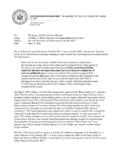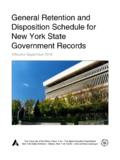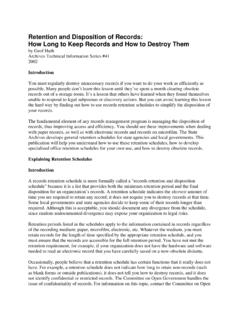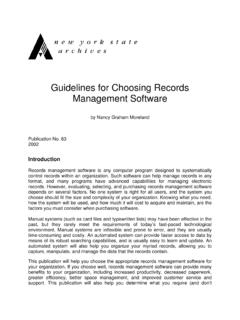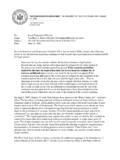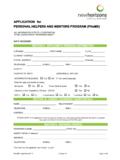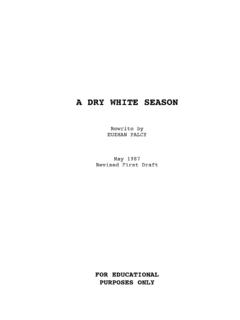Transcription of Researching the History of Your School: Suggestions f or ...
1 1 Researching the History of your school : Suggestions f or Students and Teachers The State Education Department does not discriminate on the basis of age, color, religion, creed, disability, marital status, veteran status, national origin, race, or sex in the educational programs and activities which it operates. Inquiries concerning this policy of equal opportunity and affirmative action should be referred to the Department's Affirmative Action Officer, Education Building, Albany, NY 12234. Phone (518) 473-1265. The University of the State of New York THE STATE EDUCATION DEPARTMENT State Archives 1985 2 THE UNIVERSITY OF THE STATE OF NEW YORK Regents of The University (With years when terms expire) 1988 WILLARD A.
2 GENRICH, Chancellor, , , , , , , ..Buffalo 1987 MARTIN C. BARELL Vice Chancellor, , , , ..Muttontown 1986 KENNETH B. CLARK, , , , , , , ..Hastings on Hudson 1989 EMLYN I. GRIFFITH, , ..Rome 1991 JORGE L BATISTA, , , Bronx 1986 LAURA BRADLEY CHODOS, , ..Vischer Ferry 1991 LOUISE P. MATTEONI, , , Ph. D..Bayside 1988 J. EDWARD MEYER, , , ..Chappaqua 1987 R. CARLOS CARBALLADA, , , ..Rochester 1988 FLOYD S. LINTON , , , , , ..Miller Place 1988 SALVATORE J. SCLAFANI, , ..Staten Island 1989 MIMI LIEBER.
3 Manhattan 1985 SHIRLEY C. BROWN, , , ..Albany 1990 NORMA GLUCK, , , ..Manhattan 1990 THOMAS R. FREY, , ..Rochester President of the University and Commissioner of Education GORDON M. AMBACH Executive Deputy Commissioner of Education ROBERT J. MAURER Deputy Commissioner for Cultural Education CAROLE F. HUXLEY State Archivist LARRY J. HACKMAN 3 Contents I. Introduction .. 4 II. The Development of Elementary and Secondary Education in New York .. 6 III. Milestones in the History of Education .. 14 IV. Historical Resources Available in the Community.
4 16 V. Locating and Using Historical Resources .. 19 VI. Interdisciplinary Activities With Historical Records .. 21 VII. For Further Reading .. 24 4 I. Introduction The year 1984 marked the Bicentennial of the Board of Regents and The University of the State of New York. The University includes all educational institutions in the State, and the Regents are the governing and policymaking body for the University. To help commemorate the accomplishments of two centuries of education in New York State, the State Archives has produced this booklet, Researching the History of your school .
5 The booklet describes how students and other researchers can use historical resources in their community to explore the History of their school and to determine how that History relates to communitywide and statewide developments. Because the State Archives has statutory responsibility for supervision over the records of public schools and other local governments, and because we are especially familiar with public school records and other local government records, the manual is written primarily from the perspective of the public schools. However, the underlying theme of the manual - that local resources can be used by students and teachers for the recovery and understanding of local educational History - applies to nonpublic schools as well.
6 Most nonpublic schools will have records that are similar to the public records examples cited, and most of the activities suggested in the manual are as relevant to students in nonpublic schools as to those in public schools. Through these activities, students can develop a better perspective on their own educational experience. The activities presented in the manual can be used on either the elementary or secondary levels, assuming appropriate adjustment is made to suit the grade level. Students can benefit in several ways from Researching their school 's History .
7 Whether students are looking into the History of school buildings, considering reasons for curriculum changes, Researching school sports, or examining changes in disciplinary procedures over the years, the "real" record can lead them to become deeply involved in their subject. This is History that is near at hand and that has a direct connection to their lives. Students also develop a better appreciation of their school and how it has evolved. They learn to relate the History of their own school to broader educational developments in New York State. Finally, they can discover how to relate the History of the community's central educational institution - the school - to the broader History of the community itself.
8 This, in turn, leads students to consider their own role as citizens of both the school and the community. Researching and interpreting school History also helps develop sound cognitive skills. Study of photographs, letters, yearbooks, minutes of meetings, special reports, and other sources encourages the development of information-gathering and reading skills. Through first-hand experience with original sources, students learn how to reconstruct History from available historical evidence. Sometimes that evidence is incomplete, inconclusive, or even contradictory; this challenges students to weigh the evidence for themselves and reach their own conclusions.
9 This process encourages the development of critical thinking skills. Students can be encouraged to put their newly acquired historical insights to work, through question-and-answer sessions, class discussions, and structured debate on the meaning and significance of historical events. Writing skills can be developed through assignments requiring students to summarize what they have learned, to express their own views on specific developments in school History , and to use proper forms of citation for the primary sources they have consulted. 5 The booklet begins with a short historical essay describing changes that have had ramifications for education at the local level throughout the State.
10 A list of "milestones in education" provides an additional chronological framework for study of an individual school 's History . Other chapters describe historical records and other resources, indicate how to locate them, and suggest ways of using them in classroom settings. A final section provides Suggestions for further reading both in the History of education and in the techniques of using historical records and other historical sources to teach History . This project was coordinated by the External Programs Office of the State Archives. David M. Ment, Head, Special Collections, Milbank Memorial Library, Teachers College, Columbia University, wrote the historical essay and provided the list of milestones and the Suggestions for readings on the History of education.

